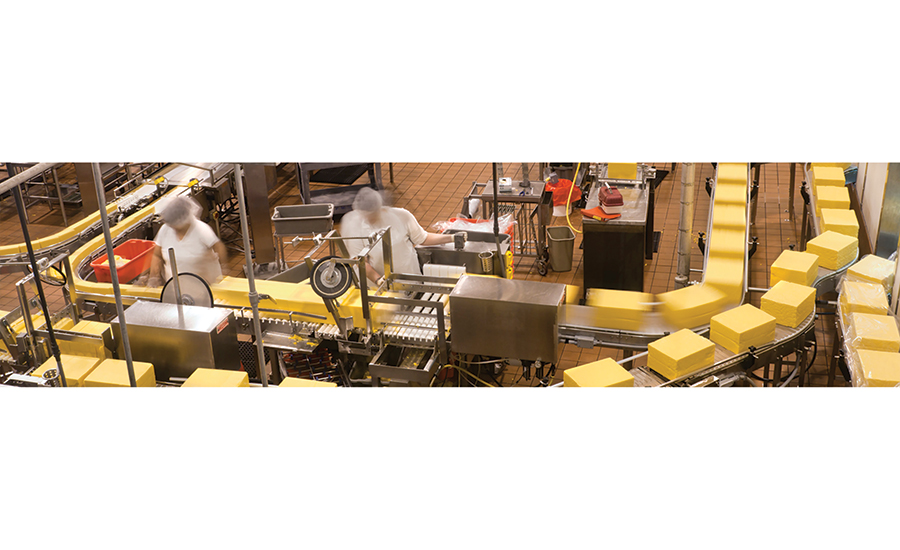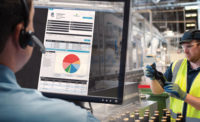Spotlight Feature
Using IIoT to Improve Packaging Line Performance
Incremental implementation of the IIoT by plant engineers and other experts is the best route to success.

Food packaging plants face a host of challenges in terms of eliminating food waste, improving safety and increasing uptime. These challenges are heightened by a confluence of external factors including pressure on margins, responding to real-time demand, requirements to use sustainable materials and others.
Many of these issues can be addressed by applying the industrial internet of things (IIoT) and related edge technologies in a systematic and incremental manner. Specifically, this will require more comprehensive data collection, reporting and analytics across the supply chain. Here we look at issues facing packaging plant managers and other personnel, and then show how the problems can be solved through intelligent implementation of IIoT solutions.
Production Challenges Margin Pressures
Pressure on margins is a fact of life for most manufacturers, especially in packaging where thin margins are impacted by small changes that can result in significant percentage differences in costs. Margin pressures are heightened by other production improvement initiatives because dealing with these issues usually requires at least some initial outlay in capital or operating expenses.
U.S. EPA 2030 Food Loss & Waste Reduction Goals aren’t yet a regulation, but very well may be in the near future. These types of goals should be considered because, when implemented correctly, they can save money and improve the image of the brand name on the package.
Safety
Safety is another ongoing issue. It can be divided into two parts: the safety of plant personnel and protection of the product encased in the packaging. As with food loss and waste reduction, improving safety will have an initial cost, but can save money in the long run, and improve or at least maintain brand reputation.

PackML
Compliance with the PackML technical standard is becoming a requirement for many packaging plants. Initial standardization efforts and implementations can be burdensome, but when implemented correctly, gains in terms of improved data exchange can outweigh costs.
Track and Trace
Another supply chain issue is tracking and tracing not only the contents, but also the packaging materials across the production process, often until a product is purchased by a consumer. While the effects of traditional packaging materials on the products encased was minimal to non-existent, the effects of newer materials are somewhat of an unknown, especially if the materials are biodegradable. These materials are designed to eventually degrade after use and disposal, but if degradation occurs too quickly it can spoil product.
Sustainable Materials
Pressure to use sustainable materials is growing, and these materials are often harder to work with than traditional solutions. Because many of these materials are relatively new, issues can ripple upstream in the chain as suppliers struggle to provide packaging plants with the right properties in these newer materials.
Compounding these sustainable material problems is the ever-growing variety of food products and packages. Where there were once one or two varieties of yogurt, for example, there are now scores of different variations, with each requiring a slightly different package. Dealing with these variations requires manufacturers to reduce changeover times, minimize downtime and maximize throughput.
Solutions
Now that we’ve looked at some of the leading production challenges found in packaging areas, let’s consider solutions.
Acquiring and Using Data
Many of the challenges faced by packaging plant personnel can be addressed by better use of existing data, by acquiring new data and by subsequently analyzing this data more effectively.
Modern automation packaging plants are typically controlled by programmable logic controllers (PLCs). These controllers not only provide real-time automation, but also act as data collectors and concentrators. Controllers are usually connected to human machine interface (HMI) platforms, often PC-based, but increasingly running on industrial edge computing platforms. Most HMIs come with the hardware connections and software protocols required to send data to data analytics software systems running either on-premises or in the cloud.

An added IIoT implementation is often the best solution when new points of data need to be acquired, stored and analyzed. It’s common to have packaging machines running with just enough data points connected to the PLC to provide real-time automation, but not enough to meet the current and future challenges faced by manufacturers listed above.
Adding these new data points using traditional methods can be cumbersome and expensive. It requires installing a new sensor or instrument, wiring it to the PLC and configuring the PLC and HMI software to exchange the new data.
The IIoT approach can greatly simplify the process across the engineering life-cycle. New data points can often be added by installing wireless sensors powered with built-in batteries. By configuring update rates to send data only when it changes, sensor batteries can last for up to 10 years. Some wireless sensors include energy harvesting components that can scavenge power from vibration or heat to power batteries, extending battery life to decades.
Whether new sensors are wireless or wired, it’s often more cost effective to bypass the PLC and connect them directly to HMIs and other higher-level data collection and analytic computing platforms. These connection methods use either company intranets and/or the internet, putting the “I” into the IIoT.
HMIs and higher-level computing platforms, such as asset management or data analytics software, can be on premises or cloud-based, using either secure intranet or internet connectivity respectively.
Now that we’ve examined the mechanics of the IIoT, let’s look at how it can be used to address challenges.
Incremental IIoT
Many IIoT implementations fail because they are focused on proving the technology, instead of on the problem and its solution. It’s easy to become overwhelmed with IIoT terminology, from machine learning artificial intelligence to blockchain and everything in between.
Some vendors tout their technologies and suggest packaging plants must implement them right away or risk being left behind, but the reality is very different. Vendors without substantial knowledge of the particular packaging application often push their technologies because it only requires them to understand how their own products work. This is the easy part.
The hard part is understanding how to address the specific problems and opportunities faced by a particular packaging line, and then providing technology-based solutions to address them. This requires deep domain knowledge, preferably of the entire food/packaging supply chain.
Vendors must work closely with packaging personnel to incrementally implement IIoT-based solutions. The proposed solutions must be user friendly and not require ongoing support from the vendor, the plant or corporate IT personnel. Instead, the existing operations technology (OT) personnel in the plant should be able to implement and support the solution.
Once the right applications and IIoT technologies are selected, implementation needs to be incremental, starting with a well-defined problem and providing a solution. Once this is done, results can be disseminated throughout the company to build interest and enthusiasm for further implementations.
One caution with this approach is to select only those technologies that are scalable, working just as well to solve one simple problem as to solve hundreds of problems across an entire fleet of packaging lines. This is especially important as more complex problems are often solved by simultaneously examining many different data points, in some cases across multiple machines located at different locations.
Scalability requires a computing infrastructure to support existing applications while enabling new IIoT additions. This can often be done by leveraging virtualization, for example. This technology allows multiple applications, and even multiple operating systems, to run on a single virtual machine, usually a PC or server.
Packaging Problems and IIoT Solutions
As mentioned, more complex packaging problems often require comparison and contrasting performance from one line to another, with these lines often located in different plants. Remote and edge data collection, with the data provided to the cloud, provides a means to examine performance remotely by multiple experts working collaboratively. Data analytics software can aid this effort by simplifying the task of cleansing and examining data to create new insights.

Providing more in-line quality and performance data for use locally where production occurs, as well as cloud-based analytics across the entire supply and demand chain, will result in better traceability. It will also result in improved matching of production planning and scheduling to meet real-time demand, and can facilitate predictive failure analysis.
A big part of sustainability is monitoring and minimizing energy consumption. This often requires the addition of new data points to monitor temperatures, power usage, steam flows and other variables. Comparing this newly acquired data to utility pricing can help plants optimize energy use. IIoT-based solutions are ideal to address these types of issues because they allow data from many different sources to be examined and analyzed more cost effectively than ever before.
Data acquired by installing sensors, hardware and software can be used to minimize the use of packaging materials, and to simplify material usage across multiple product SKUs.
Minimizing food waste starts with putting precise amounts of products into packages. Too little violates basic rules and laws requiring manufacturers to provide the amounts of products listed on the packages; and too much results in product giveaway and possibly leakage due to overfilling. The addition of in-line sensors and the analysis of the data they provide can address these issues by helping manufacturers close the loop on product filling.
Improved IIoT sensors, data points and analytics will provide better traceability and demand/supply planning from farm to fork — along with improved insights into packaging materials, equipment operation, performance and maintenance.
The key is to start small with an incremental approach focused on problems, new opportunities and solutions — instead of trying to install all of the latest IIoT technologies at once, and then searching to see if they can be made to work in your packaging area or plant
Looking for a reprint of this article?
From high-res PDFs to custom plaques, order your copy today!






